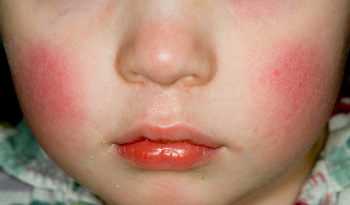If you notice red blotches on your baby's face after eating, it can be quite common as babies start to try new things. Their delicate and immature immune system doesn't quite know some of the proteins in foods other than breastmilk or formula. It can either be a food sensitivity to watch or an allergic reaction. This is why your pediatrician likes you to start new foods one by one for the first few days. It will help you see what your baby can tolerate, and what he/she can't. This article will give you some of the most common cause of food rashes, and things you can do to help.

Red Blotches on Baby Face after Eating: Causes and How to Help?
During your baby's first year, you will be helping him/her explore all the new tastes and textures of different foods. True food allergies are actually quite uncommon in babies, but their immature immune system may react due to many different reasons. These include:
1. Intolerance to Additives
Your baby may not be allergic to an actual food, but intolerant of additives that were put in processed foods. Some food grade chemicals can cause skin reactions, and these include glutamates (MSG), food coloring, flavors, and food preservatives. Keep in mind this issue is not an actual food allergy, but a sensitivity to a chemical.
Other symptoms may include wheezing after eating certain foods, tummy problems (vomiting, diarrhea), throat swelling, and hives all over the body.
Treatments: If you are feeding your baby processed foods, your doctor may have you remove the offending foods from the diet. Your baby may do better with freshly prepared foods from scratch with no additives. If a reaction is severe, your baby may need a short course of steroids to calm down the reaction.
2. Food Allergies
If your baby is allergic to a certain food, you may notice red blotches on baby face after eating, or even during their actual meal. Food allergies are actually an allergy to certain proteins in foods. The immune system cannot tolerate the protein and rushes to fight it off with responses that cause reactions. Common foods that cause this include tree nuts, peanuts (legume family), berries, milk, eggs, corn, and wheat.
Symptoms of a food protein allergy include blotches on the face, hives, swelling in the face, wheezing, trouble breathing, and anaphylactic shock.
Treatments: If severe food allergies occur, remove the offending food from your baby’s diet right away. Your doctor may have you give a daily dose of antihistamine to protect from reactions. Make sure any foods that are taken from your baby's diet are replaced with a safe alternative to replace needed nutrients.
3. Rosacea
Rosacea is not as common in babies as adults, but can occur. It is a skin issue that causes blotchy red areas on the cheeks and face. Rosacea has nothing to do with food allergies. However, certain foods may trigger the "flushing" in rosacea, which is caused by increased blood flow to the blood vessels in the face. Trigger foods include vanilla flavoring, soy products, liver, Yeast, sour cream, and chocolate.
Symptoms of rosacea include bright red blotches on the cheeks, skin that is hot to touch, red bumps on the face, stinging, itching, and fussiness.
Treatments: Avoid foods that trigger rosacea, protect skin from the sun, use mild skin cleansers, and avoid lotions with fragrance.
4. Eczema
Eczema is an immune system condition that affects the skin. Around 10 percent of infants in the United States suffer from eczema, but it may be more common worldwide. Researchers don't know exactly what causes eczema, but it is strongly related to family history, and the environment that you live in. Doctors do know that certain foods can trigger eczema including cow's milk, eggs, soy, gluten, shellfish, nuts, and fish.
Symptoms of eczema include skin rashes, itchiness, and even asthma attacks. Red blotches on baby face after eating can occur after eating foods that trigger eczema.
Treatments: Doctors may suggest removing any foods in the diet that trigger eczema. You may also need to keep a thick cream on hand to use on the patches of skin that break out often. In extreme cases, your pediatrician may prescribe steroids.
5. Actual Food Stains
Certain foods can stain the skin on the face. There are also some foods that contain red dyes as a food additive, but in not-so-obvious foods. This includes barbeque sauce (can stain red), blueberries, cherries, strawberries, rhubarb, beets, pomegranate seeds, and believe it or not, salmon.
Symptoms of red food stains are very easy to discern. You will be able to wash off the red blotches easily with warm soapy water. There will also be a lack of other symptoms as stated in the above situations. Your baby will only have red blotches that wash off and no respiratory symptoms or rashes that develop anywhere else. You may notice some redness remaining if there is a mild skin reaction to the coloring.
Treatments: Wash skin with mild soapy water. If there are no signs of food allergy, you can try a small amount of petroleum jelly to baby's face prior to eating staining foods. Use only a thin layer. Protecting the skin will also help prevent any localized skin reactions to the food color.
